 Applied Mineral Exploration
Applied Mineral Exploration Discussion and research relevant to mineral
exploration.
Discussion and research relevant to mineral
exploration. |
Home |
Rapid fluid inclusion data
for exploration (decrepitation) |
Newest Topics |
Viewpoints
|
Bicycles |




